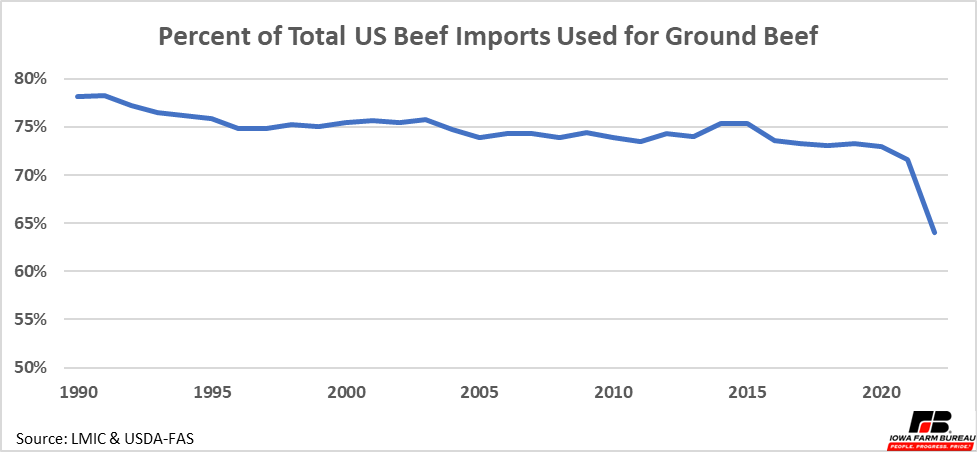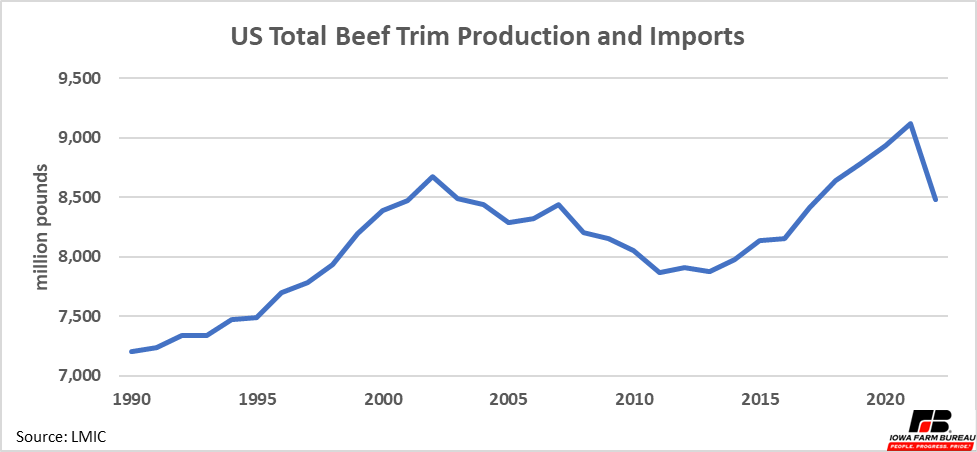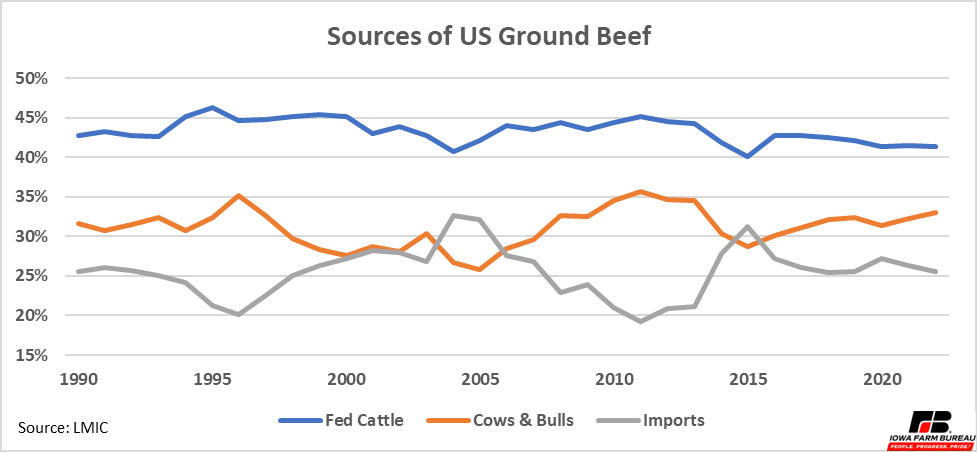US Ground Beef Imports Update
Author
Published
4/21/2023
The US is a large importer of beef, typically second only to China is terms of annual imports each year. However, the US also is one of the largest exports of beef, typically one of the four largest exporters of beef in the world. Brazil, India, and Australia represent the rest of the top four.
Why is the US involved in so much beef trade as both an importer and an exporter? The answer is the US’s ground beef consumption. Beef trimmings imports, which are combined with domestic beef trimmings to make ground beef to a variety of specifications, typically represent over 70% of beef that is imported by the US (Figure 1). Though in 2022, the ground beef slipped to 64% of beef imports.

Figure 1. Percent of Total US Beef Imports Used for Ground Beef
In 2022, US beef trimmings production plus imports totaled 8.4 billion pounds. This number has been even higher in the past (Figure 2). Beef trimmings are what remains after beef cuts like steaks have been cut to the specified size. These trimmings which can be 50% lean trimmings to 90% lean trimmings are used to make ground beef to specific fat contents (70% lean, 80% lean, 90% lean, etc.)

Figure 2. US Total Beef Trim Production and Imports
Even though the US produces a substantial amount of beef trimmings, not all beef trimmings are created equal. The fat content of trimmings varies. For this reason, trimmings from different animals are typically blended to create two commonly quoted beef trimmings products (50% beef trimmings and 90% beef trimmings) and then these trimming products are blended with ground round, ground chuck and other beef cuts to produce products such as 80% lean ground beef. Fed cattle typically produce trimming with a higher fat content than bulls and cows.
Figure 3 shows the sources of US ground beef. There are a few things to note. First, domestic production makes up about 70-80% of total ground beef and imports represent the remaining 20-30%. These numbers have stayed relatively consistent over time. Second, domestic fed cattle trimmings have always exceeded domestic cow and bull trimmings. So, if the US did not import lean trimmings, which are what the majority of trimming imports are, the US would not have enough lean trimmings to blend with higher fat trimmings to create the blends of “ground beef” that consumers prefer.

Figure 3. Sources of US Ground Beef
The US consumer has been seeking higher and higher levels of lean beef in their ground beef. There was a time when 73% lean and 27% fat was a common standard for ground beef. Today, 80%/20% is far more common and products with over 90% lean are available in many stores.
Alternatives to importing lean trimmings would likely not result in attractive outcomes for either the consumer or producer. Two possibilities and their ramifications are outlined below.
One possibility is leaving all other cuts alone and simply reducing ground beef production. This would drive up prices for ground beef simply because there would be less of it. Because the US would be short lean trimming, the fat content of ground beef would also increase. This could lead to lower consumer demand and eventually lower cattle prices.
Another alternative would be grinding more domestic muscle cuts of beef into ground beef. However, even lower quality roasts are typically worth more than ground beef on a per pound basis. Turning these into ground beef would result in a loss of value to the economy as consumers value these roasts more than ground beef. This loss of value would eventually result in lower cattle prices, higher beef prices for consumers, or most likely some combination of the two as the loss of value has to come from somewhere along the supply chain.
Want more news on this topic? Farm Bureau members may subscribe for a free email news service, featuring the farm and rural topics that interest them most!